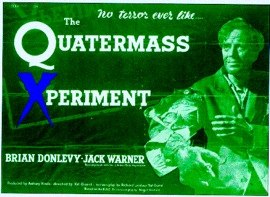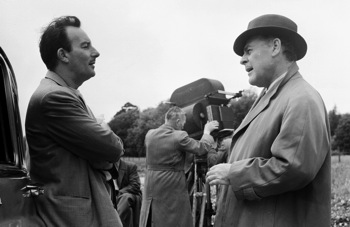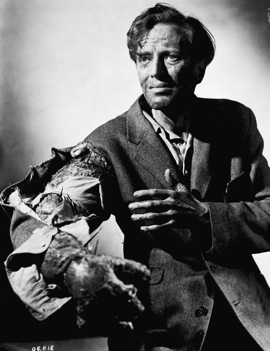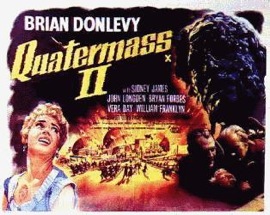|
Before Doctor Who,
There Was ...
Quatermass!
Deluxe Digital Remasters
The Quatermass Xperiment
in Hi-Def

By Glenn Erickson
The British have always loved Science Fiction fantasies. While American television screens were grinding out juvenile space opera series like Captain Video and Rocky Jones, Space Ranger, the 'Telly' in London was presenting progressive, adult and challenging Science Fiction serials.
Everyone knows who Dr. Who is now; the latest incarnation of the time traveling Doctor is an even bigger hit than the original back in the early 1960s. But only confirmed Sci-Fi addicts are familiar with his no-nonsense predecessor, Professor Bernard Quatermass. The head of Britain's Rocket Research Group, Quatermass was the focus of three highly popular TV serials in the 1950s, each of which pitted the professor against a new kind of invasion from outer space. Hammer Films adapted all three of the serials into feature films. The character was extended as far as 1980, to a final installment with John Mills filling the role of Professor Quatermass.
All of the series entries are now available on DVD save for the very first film adaptation, 1955's The Quatermass Xperiment, directed by Val Guest for Hammer Films and distributed in the U.S. by United Artists. 1 One of the most famous and influential Sci-Fi films ever, the movie introduced a gruesome new concept. The first man into space returns to earth infected with an extraterrestrial 'thing' that causes him to absorb other life-forms -- zoo animals, a spiny cactus -- until he devolves into a jellyfish-like monster. The movie introduced filmed Sci-Fi to the notion of an invasion that's biological in nature. Man in space may expose our planet to alien organisms over which we have no control. The conquest of the cosmos could invite the 'colonization' of our home world by things unknown.
The movie starred American actor Brian Donlevy, who made Quatermass into a brusque, bull-headed obsessive impatient with bureaucrats and meddlers. A remarkable actor named Richard Wordsworth interpreted the mute, metamorphosing astronaut as a confused, tormented soul. Wordsworth's pantomime approaches the great work by Boris Karloff as the Frankenstein Monster, especially when he reveals that one entire arm has become a club-like appendage studded with cactus thorns. The astronaut even menaces a young girl, in a scene clearly modeled after one in Frankenstein.
The influence of The Quatermass Xperiment spreads far and wide, wherever alien 'things' try to prove Jurassic Park's thesis that 'life will find a way.' The Blob, Caltiki The Immortal Monster, The Andromeda Strain and other creatures were surely inspired by Xperiment, and Alien's idea of a helpless man inoculated with an extraterrestrial life form fits the pattern as well. David Cronenberg's many movies about fleshy parasites and horrible physical transformations (Shivers, the remake of The Fly) are conceptually linked to Quatermass as well. The alien 'thing' in The Quatermass Xperiment is like one of Cronenberg's nasty tumors that turns a man into a new kind of creature.

Although considered an essential title in any examination of the Sci-Fi genre, The Quatermass Xperiment hasn't made it to DVD. Its cast no longer has any marquee value, and I don't remember its earlier VHS and laserdisc versions breaking any sales records. What's worse, studios with big libraries are cutting back on older titles, particularly those in B&W.
When I was an editor at MGM, I did some research to help differentiate between the original English version (82 minutes) and the shorter American cut, re-titled The Creeping Unknown (79 min.) In late 2003 I was hired to edit an interview with director Val Guest into a pair of featurettes for a proposed The Quatermass Xperiment release that never came to be. We're still hoping that a DVD surfaces, as all of the Quatermass TV serials and features are now available on DVD except for this original success.
Not long ago I heard that the title was being worked on again. Deluxe Digital now handles film asset management and library maintenance for MGM. They're finishing a new Hi-Def restoration on The Quatermass Xperiment and I asked if I could write about it. Let me say right up front that the remastering of the title is not being done for DVD, and no disc release has been planned or scheduled.
Back in 1995, MGM's old Technical Services department did Sci-Fi fans a favor. When a laserdisc of United Artists Science Fiction movies went into production, instead of simply transferring the shorter, inferior-looking American version The Creeping Unknown, MGM contacted the British Film Institute for a dupe of their intact original copy. The result was a version Americans had never seen, complete with censored shots of shriveled victims and a creepy close-up of the amoeba-like alien crawling on the floor.

Director Val Guest and Brian Donlevy as Professor Bernard Quatermass.
Deluxe Digital's Mary Grace Nicolas was the point person assigned to oversee the restoration. She started from scratch, comparing old transfers and versions. It goes without saying that video transfers have improved exponentially in the last fifteen years.
As the film elements had to remain in the UK, MGM's London office arranged for an HD transfer of the British Film Institute's fine grain positive, the original having been lost some time ago. MGM has a good relationship with the BFI; not too long ago the studio and the Institute located a beautiful copy of The Ghoul, a 1933 Boris Karloff chiller that was thought to have been lost.
Deluxe Digital's goal with The Quatermass Xperiment was to manufacture a new digital master. Mary Grace described the process as similar to newer film work involving Digital Intermediate manipulation. Most feature films are now transferred to digital video straight from the camera negative, which may never be touched again.
Working with old movies is similar, except that the quality can be limited by the condition of the surviving film elements. The raw HD transfer for Xperiment looked fine but the film's many night scenes had plenty of white speckles. Occasional damaged frames needed to be cleaned up as well. Most of the digital cleanup work on the Hi Def image was done by Paul Schramm at Hollywood's Post Group facility.
As no records could be found to establish the film's precise aspect ratio -- even the BFI was unsure -- the movie was transferred to HD pillarboxed at 1:33. Judging from the look of most scenes, with plenty of head and foot room, the aspect ratio probably should have been 1:66. But when framed at that wider screen shape, part of the main titles crowded the masking.

Richard Wordsworth is Victor Carroon, an astronaut infected with an Alien contamination.
MGM and Deluxe Digital did get one thing absolutely correct. Because MGM's records still list the film under its very uncool American name, for a while the movie was going to be mastered with the ragged The Creeping Unknown title card up front. The American title sequence was so poorly designed, the distribution company was given as "United Artist", missing the final "s". A movie company has to be pretty cheap not to spell its own name right in the credits.
Happily, the title retained is the British original. By the way, Hammer Films purposely misspelled the word "Experiment" as "Xperiment" to let English movie fans know that the movie had been issued a BBFC Certificate "X" rating -- for adults only. The Quatermass Xperiment launched Hammer Films as a maker of daringly gory (for the 1950s) horror product. The new transfer also carries the original end card, which properly credits Hammer Films.
Chace Audio of Burbank remastered the film's soundtrack from digital transfers made from the film's fine grain optical negatives. I asked to sit in on part of The Post Group's audio layback session, where I could see for myself just what kind of quality could be gotten from a 53 year-old movie. The original American release of the film was criticized for being too dark, and even the handsome laserdisc was a bit on the murky side.
On May 9, I watched part of the layback. The movie never looked better, with a rich B&W image and crisp audio. The detail in HD was remarkable. The film's matte shots still looked good. The new transfer gives us a much better look at Richard Wordsworth's final form, a combination animal-vegetable octopus-amoeba, trapped atop a scaffold in Westminster Abbey.
Post Group audio engineer Troy Smith had already synchronized audio to video, and everything lined up beautifully. The BFI had also provided a music & effects-only track for use when dubbing into foreign languages. Oddly enough, Troy found a track discrepancy in the final reel. When Quatermass leaves the video booth to take a look what was left of his unlucky astronaut, the tracks provided went thirteen seconds out of sync. Apparently the film was trimmed after the track negatives were made, and a shot of Quatermass's friend following him through the Abbey was abridged. Troy did one fast pull-up and the track was resynchronized.
So here's hoping that The Quatermass Xperiment eventually finds its way to DVD, or maybe even Blu-ray, should that format explode in popularity. I don't know what this specific transfer was made for, but if forced to guess I'd say it's for HD cable. After asking a few questions and probably talking too much, I left the session so that Troy and Mary Grace could get on with their work. Mary Grace did ask me what made the movie so important, so I have a good Xcuse.
The Quatermass legacy includes:

The original TV serials:
The Quatermass Experiment (1953),
Quatermass II (1955), and
Quatermass and the Pit (1959).
The Hammer Films adaptations made from them:
The Quatermass Xperiment (The Creeping Unknown) (1955),
Quatermass 2 (Enemy From Space) (1957),
and Quatermass and the Pit (Five Million Years to Earth) (1967).
And the BBC's 1979 revival TV serial, known simply as Quatermass.
It was trimmed down to a single feature and given a 1980 theatrical release as The Quatermass Conclusion. 2
See also Savant's early (1997) overview of the Quatermass series,
Quatermass Who?
Republished in concert with Film.com.
Footnotes:
1. Actually, Region 2 discs of The Quatermass Xperiment have been released, as I've been corrected by several readers. I admit that I don't take these PAL releases seriously -- they almost always run at 25fps, which changes the pace of the dialogue (even if pitch corrected) and makes a mess of music tracks ... Savant isn't the most sensitive viewer, but watching movies running at a 4% higher speed is like watching time-compressed television shows -- a big headache. If this is an ignorant bias, I still haven't heard a persuasive rebuttal.
Return
2. A note from reader Sergio, 6.14.08: Dear Glenn, congratulations as ever with your various columns, they're always a real treat to read. With regards to your coverage of the Quatermass films at Films.com, it is worth noting that the final TV serial (it isn't quite the last story as Kneale did also write a radio play entitled The Quatermass Memoirs in 1996, available on CD in the UK) starring John Mills, while originally projected to be made by the BBC in the early 1970s was eventually rejected by them. As a result Kneale left the BBC and the serial was belatedly produced for ITV by Euston Films, a division of Thames TV, which was headed at that time by Verity Lambert, who was the original producer of Doctor Who from 1963 to 1965. To further add to the Doctor Who connections, in 2005 the BBC presented a live performance of a 90-minute adaptation of Kneale's original The Quatermass Experiment which co-starred ... David Tennant.
Thought all this might be of interest. All the best, Sergio
Return
DVD Savant Text © Copyright 2008 Glenn Erickson
Go BACK to the Savant Main Page.
Reviews on the Savant main site have additional credits information and are more likely to be updated and annotated with reader input and graphics.
Return to Top of Page
|











